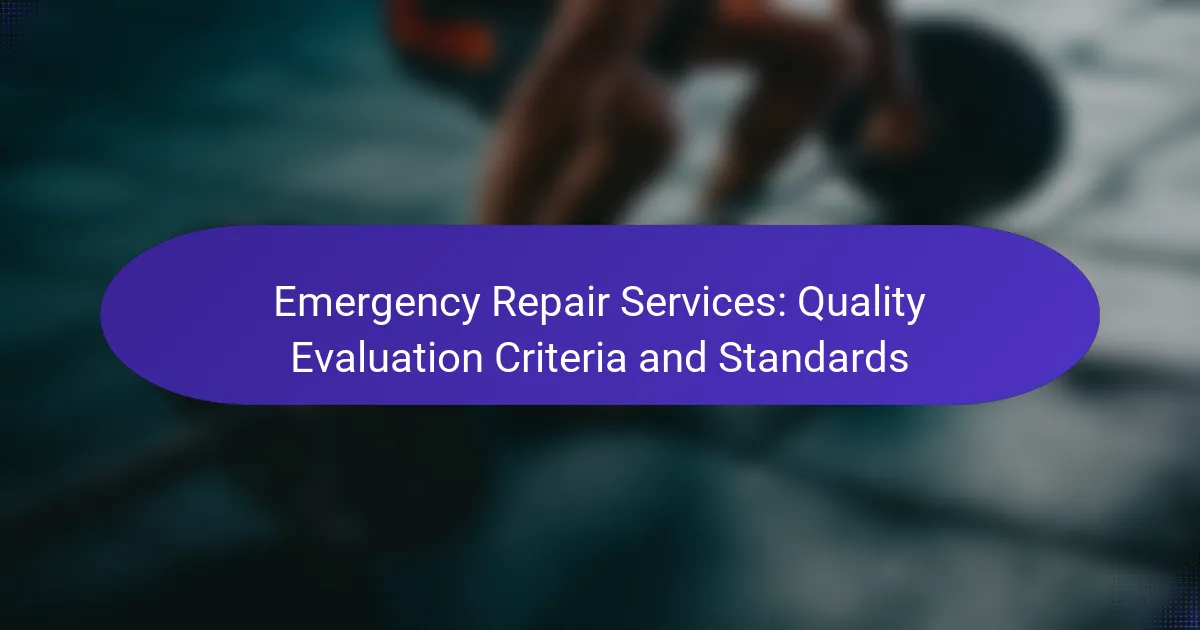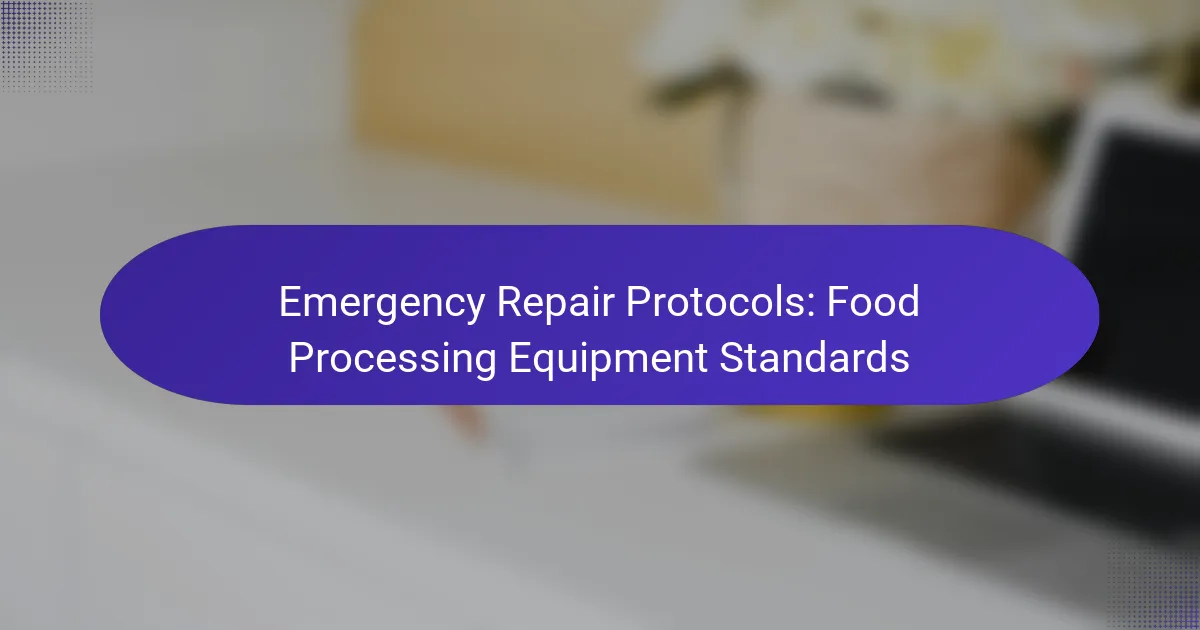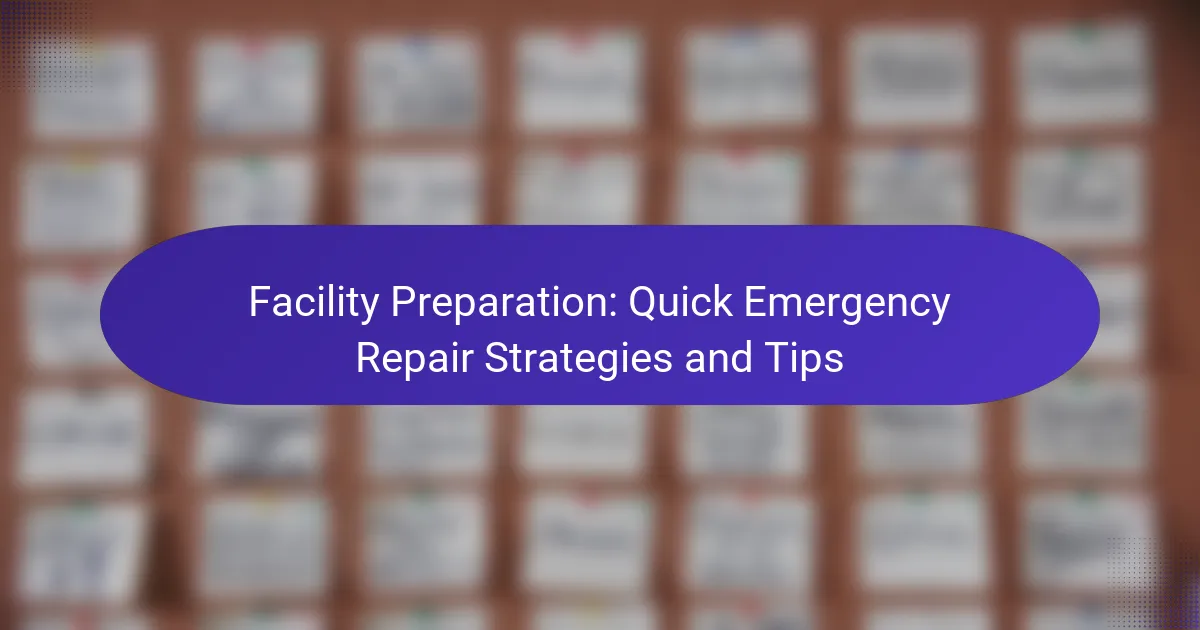Choosing the right emergency repair service for critical equipment is essential for minimizing downtime and ensuring efficient operations. Key selection criteria include response time, technician expertise, and the range of services offered. By focusing on these factors, you can ensure that your equipment failures are addressed promptly and effectively.
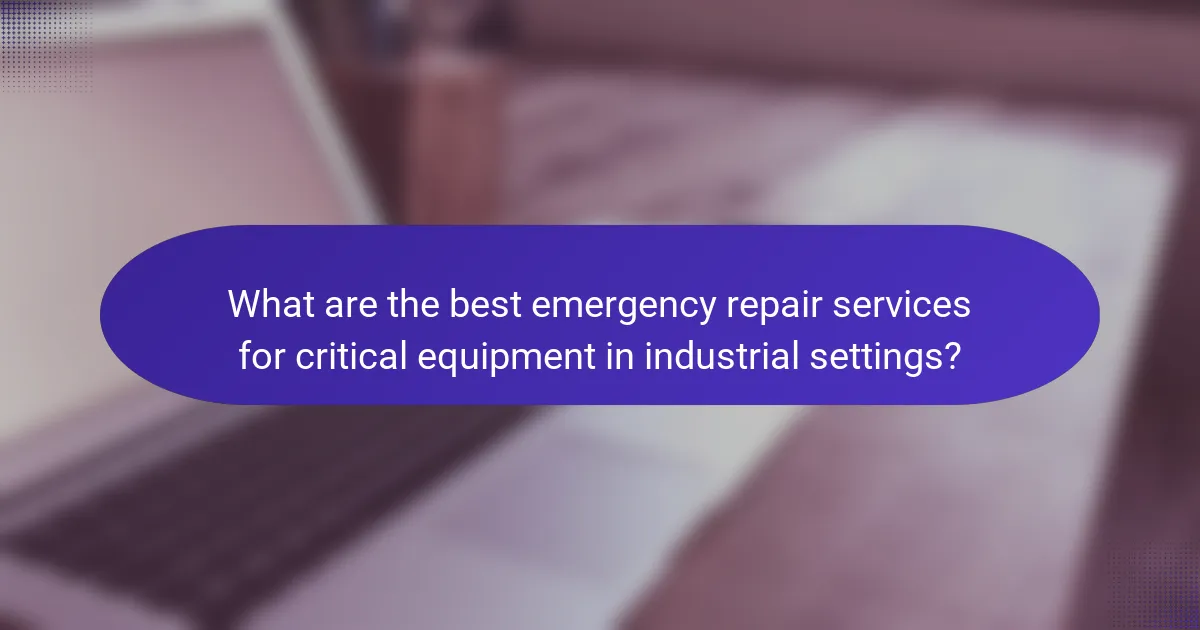
What are the best emergency repair services for critical equipment in industrial settings?
The best emergency repair services for critical equipment in industrial settings are those that provide immediate support, skilled technicians, and a wide range of services. Selecting a service that meets these criteria ensures minimal downtime and efficient resolution of equipment failures.
24/7 Availability
Emergency repair services must be available 24/7 to address unexpected equipment failures at any time. This constant availability allows businesses to quickly resolve issues, reducing the risk of prolonged downtime and financial losses.
When evaluating services, confirm their operational hours and response capabilities. Some companies may offer tiered support, so ensure you choose one that guarantees immediate assistance around the clock.
Expert Technicians
Having expert technicians is crucial for effective emergency repairs. These professionals should possess extensive experience and specialized training in handling critical industrial equipment.
Look for certifications and qualifications that demonstrate their expertise. A service with a team of skilled technicians can quickly diagnose problems and implement solutions, minimizing disruption to operations.
Rapid Response Times
Rapid response times are essential for emergency repair services, as delays can lead to significant operational losses. Aim for services that can arrive on-site within a short time frame, ideally within a couple of hours.
Consider asking potential service providers about their average response times and any guarantees they offer. A reliable service should have a proven track record of prompt arrivals and efficient problem-solving.
Comprehensive Service Offerings
Comprehensive service offerings ensure that all aspects of equipment repair and maintenance are covered. This includes not only repairs but also preventive maintenance, inspections, and parts replacement.
When selecting a service, evaluate their range of services to ensure they can handle various types of equipment and issues. A one-stop solution can simplify logistics and improve overall efficiency in managing critical equipment repairs.

How to evaluate emergency repair service providers?
To evaluate emergency repair service providers, focus on their qualifications, customer feedback, and response times. These factors will help ensure you select a reliable service capable of addressing critical equipment failures efficiently.
Check Certifications
Verifying certifications is essential when selecting an emergency repair service provider. Look for industry-specific credentials that demonstrate expertise and adherence to safety standards. Common certifications include ISO 9001 for quality management and relevant local licenses.
Additionally, check if the technicians are certified by recognized organizations, which indicates they have undergone proper training. This can significantly impact the quality of service you receive during an emergency.
Review Customer Testimonials
Customer testimonials provide insight into the reliability and effectiveness of a repair service. Look for reviews on independent platforms, as these are often more trustworthy than those on the provider’s website. Pay attention to comments about the quality of work and customer service.
Consider reaching out to past clients for direct feedback. This can give you a clearer picture of what to expect and help you avoid providers with a history of poor performance.
Assess Response Time Metrics
Response time is critical in emergency situations. Evaluate the provider’s average response time to ensure they can arrive quickly when needed. Many reputable services aim for response times within one hour, but this can vary based on location and time of day.
Ask potential providers about their response time metrics and any guarantees they offer. Understanding their capacity to handle urgent requests will help you make an informed decision and ensure minimal downtime for your critical equipment.

What are the key criteria for selecting an emergency repair service?
When selecting an emergency repair service, key criteria include their response time, reliability, and expertise in handling critical equipment. These factors ensure that your operations can resume quickly and efficiently, minimizing downtime and potential losses.
Service Level Agreements (SLAs)
Service Level Agreements (SLAs) define the expected performance and quality of service from the repair provider. Look for SLAs that specify response times, repair timelines, and penalties for non-compliance. A strong SLA can provide assurance that the service will meet your urgent needs.
Consider SLAs that include provisions for regular performance reviews and updates. This helps ensure that the service remains aligned with your operational requirements over time. For example, an SLA might guarantee a response within two hours for critical failures.
Cost Transparency
Cost transparency is crucial when selecting an emergency repair service. Ensure that the provider offers clear pricing structures, including any additional fees for after-hours service or expedited repairs. This helps avoid unexpected charges that can strain your budget.
Request a detailed breakdown of costs, including labor, parts, and travel expenses. Comparing quotes from multiple providers can also help you identify reasonable pricing and avoid overpaying for services. Aim for providers who are upfront about their pricing policies.
Geographic Coverage
Geographic coverage is an essential factor, especially if your operations span multiple locations. Choose a repair service that can quickly reach all your sites to minimize delays in response times. Local providers may offer quicker service, but ensure they have the capacity to handle your specific equipment needs.
Evaluate the provider’s service area and any potential limitations. For instance, if you operate in remote regions, confirm that the service can still meet your emergency repair needs without excessive delays. A provider with a broad geographic reach can be advantageous for businesses with multiple facilities.
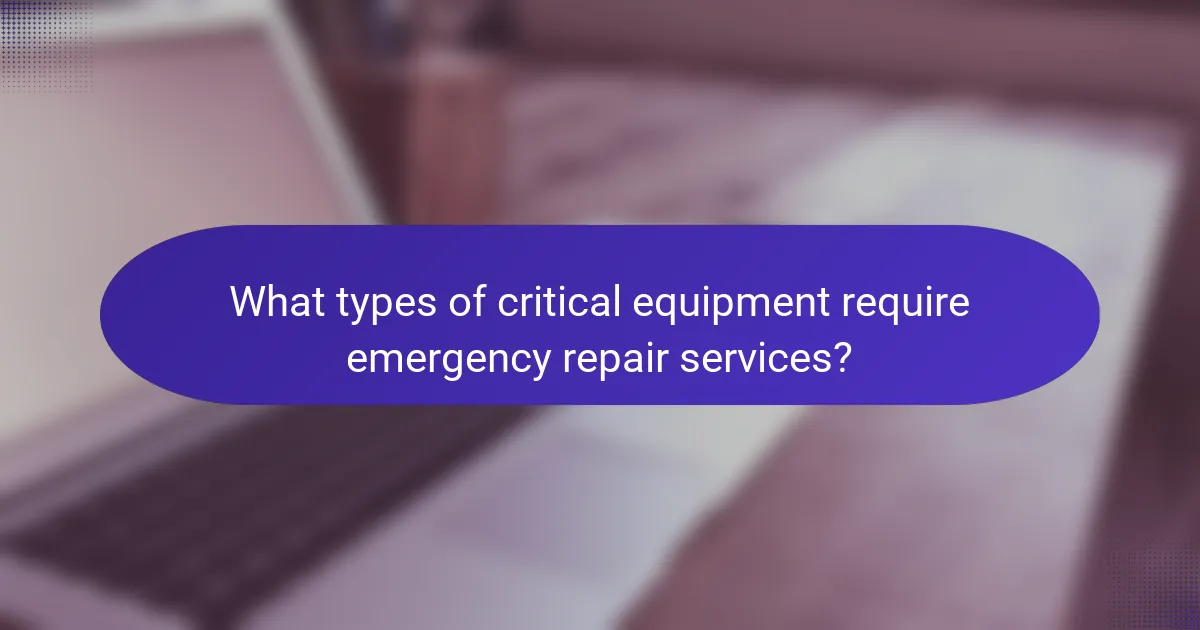
What types of critical equipment require emergency repair services?
Critical equipment that requires emergency repair services typically includes machinery and systems essential for operational continuity. Quick and effective repairs can prevent significant downtime and financial losses, making it vital to identify these key assets.
Manufacturing Machinery
Manufacturing machinery, such as CNC machines, conveyor belts, and robotic arms, are crucial for production efficiency. When these machines fail, the entire production line can halt, leading to costly delays. Regular maintenance and immediate access to emergency repair services can mitigate these risks.
Consider establishing a service level agreement (SLA) with a repair provider to ensure rapid response times, ideally within a few hours. This can help maintain productivity and minimize operational disruptions.
HVAC Systems
HVAC systems are vital for maintaining comfortable and safe working environments in commercial and industrial settings. A malfunctioning HVAC unit can lead to temperature extremes, affecting both employee comfort and equipment performance.
Emergency repair services for HVAC systems should be available 24/7, especially in regions with extreme climates. Regular inspections and maintenance can help identify potential issues before they escalate, ensuring reliable operation.
Electrical Equipment
Electrical equipment, including transformers, generators, and circuit breakers, is essential for powering operations. Failures in these systems can lead to power outages, posing safety risks and halting production.
To manage risks effectively, ensure that emergency repair services are familiar with local electrical codes and standards. Establishing a routine maintenance schedule can also help prevent unexpected breakdowns and enhance system reliability.

What are common issues faced by critical equipment?
Critical equipment often encounters mechanical failures, electrical malfunctions, and software glitches. Understanding these common issues is essential for effective emergency repair service selection and ensuring operational continuity.
Mechanical Failures
Mechanical failures typically arise from wear and tear, misalignment, or inadequate lubrication. These issues can lead to equipment breakdowns, resulting in costly downtime and repairs.
Regular maintenance checks can help identify potential mechanical problems before they escalate. For instance, monitoring vibration levels can indicate misalignment or imbalance in rotating machinery.
Electrical Malfunctions
Electrical malfunctions may include short circuits, power surges, or component failures. These problems can disrupt the functioning of critical systems and may pose safety hazards.
To mitigate electrical issues, ensure that all equipment is compliant with local electrical standards and regularly inspect wiring and connections. Using surge protectors can also safeguard against power fluctuations.
Software Glitches
Software glitches can occur due to bugs, compatibility issues, or outdated systems. These glitches may lead to incorrect data processing or system crashes, impacting overall performance.
To prevent software-related problems, keep systems updated and regularly back up data. Implementing a robust testing protocol before deploying updates can help minimize disruptions caused by software issues.

How can businesses prepare for emergencies with critical equipment?
Businesses can prepare for emergencies involving critical equipment by establishing a robust emergency repair service plan. This includes identifying essential machinery, assessing potential risks, and creating a response strategy that ensures quick access to repair services when needed.
Identify critical equipment
Start by determining which pieces of equipment are essential for your operations. This may include machinery that directly impacts production, safety systems, or technology that supports key business functions. Prioritize these assets based on their importance and the potential impact of downtime.
Consider creating a list of critical equipment, including details such as location, function, and maintenance history. This will help streamline your emergency response efforts and ensure that the right resources are allocated during a crisis.
Assess potential risks
Evaluate the risks associated with each piece of critical equipment. This includes understanding common failure modes, potential environmental hazards, and the likelihood of equipment breakdown. Regular risk assessments can help identify vulnerabilities and inform your emergency preparedness strategy.
Utilize tools such as Failure Mode and Effects Analysis (FMEA) to systematically assess risks and prioritize mitigation strategies. This proactive approach can significantly reduce the impact of emergencies on your operations.
Create a response strategy
Your response strategy should outline clear procedures for addressing equipment failures. This includes establishing communication protocols, identifying key personnel, and detailing steps for accessing emergency repair services. Ensure that all employees are trained on these procedures to facilitate a quick and effective response.
Consider developing partnerships with local repair service providers to ensure rapid access to skilled technicians. Having a list of reliable contacts can save valuable time during emergencies and minimize downtime.
Regularly review and update your plan
Emergency preparedness is an ongoing process. Regularly review and update your emergency repair service plan to reflect changes in equipment, technology, and business operations. Schedule routine drills to test your response strategy and make necessary adjustments based on feedback and performance.
Stay informed about industry best practices and regulatory changes that may impact your emergency preparedness efforts. This commitment to continuous improvement will enhance your resilience in the face of equipment emergencies.

